Oundle, Northamptonshire
Up to 1834
The SPCK's "An Account of Several Work-houses..." contains the following entry for Oundle, dated December 7th 1724:A building on the north side of West Street was used as Oundle's parish workhouse. It later became the Victoria Inn but is now used for private housing.
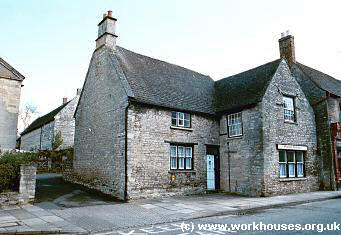
Oundle parish workhouse from the south-west, 2000.
© Peter Higginbotham.
A parliamentary Report of 1777 recorded parish workhouses in operation at: Oundle (for up to 45 inmates), Apethorpe (8), Benefield (30), Kingscliff (30), Great and Little Weldon (20), and Yarwell (6).
A house on West Street in King's Cliffe was recorded as being the parish's workhouse in 1782. In the early 19th century it became the Maltster's Arms public house.
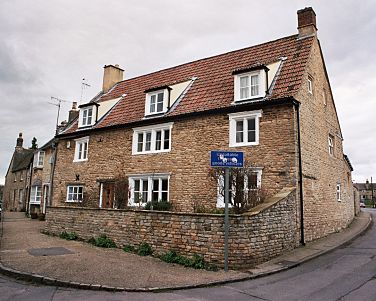
King's Cliffe parish workhouse, 2004.
© Peter Higginbotham.
After 1834
The Oundle Poor Law Union formally came into being on 1st December 1835. Its operation was overseen by an elected Board of Guardians, 40 in number, representing its 37 constituent parishes as listed below (figures in brackets indicate numbers of Guardians if more than one):
County of Northampton: Apethorpe, Armston, Ashton, Barnwell All Saints, Barnwell St Andrew, Benefield, Blatherwycke, Bulwick, Cotterstock, Deene, Deenethorpe, Fotheringhay, Glapthorn, Hemington, King's Cliffe (2), Lilford cum Wigsthorpe, Luddington, Lutton, Nassington, Oundle (3), Pilton, Polebrook, Southwick, Stoke Doyle, Tansor, Thorpe Achurch, Thurning, Wadenhoe, Warmington, Great Weldon, Little Weldon, Winwick, Woodnewton, Yarwell.
The population falling within the Union at the 1831 census had been 13,517 with parishes ranging in size from Armston (population 25) to Oundle itself (2,308). The average annual poor-rate expenditure for the period 1833-5 had been £8,901 or 13s.2d. per head of the population.
Oundle Union workhouse was built in 1836-7 at a site on the west side of Glapthorne Road to the north of Oundle. The Poor Law Commissioners authorised an expenditure of £4,400 on construction of the building which was intended to accommodate up to 150 inmates. The workhouse location and layout are shown on the 1926 map below, by which date it had become officially known as a Poor Law Institution.
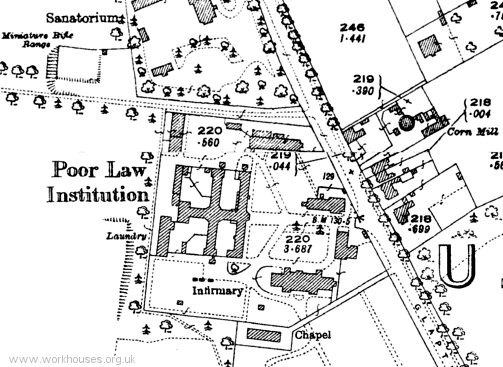
Oundle workhouse site, 1926.
The architect was George Gilbert Scott who was responsible for the design of other Northamptonshire workhouses at Kettering, and Northampton and Towcester. His design for Oundle was broadly based on the model cruciform plan published by the Commissioners in 1835. The building had a two-storey entrance block at the east, flanked by single storey wings. The central portion of the entrance block contained a porter's room and the original board-room. To the rear, four wings radiated from a central octagonal hub. The workhouse could house up to 178 inmates.
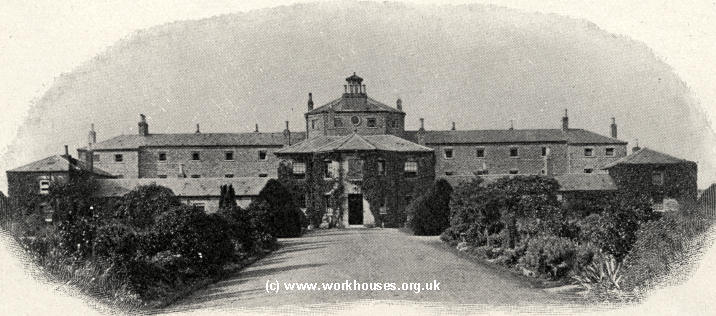
Oundle workhouse from the east, c.1894.
© Peter Higginbotham.
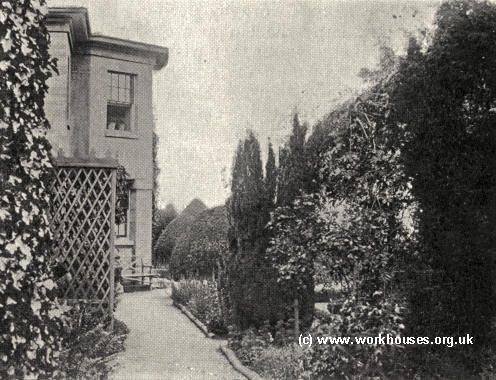
Oundle workhouse entrance block from the south, c.1894.
© Peter Higginbotham.
A separate lodge and board-room block were later erected at the entrance to the site on Glapthorne Road.
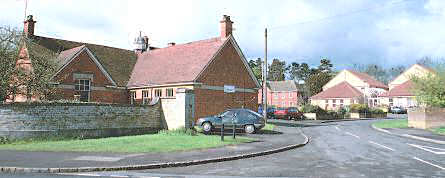
Oundle workhouse site and entrance lodge from the north-east, 2000.
© Peter Higginbotham.
An infirmary was erected to the south of the workhouse in 1900.
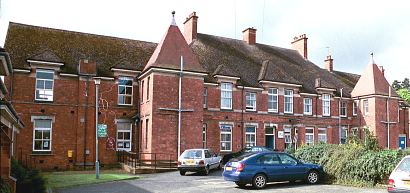
Oundle infirmary from the north, 2000.
© Peter Higginbotham.
A chapel, whose £1,000 cost was funded by charitable contributions, was erected at the south of the workhouse in the 1890s. It is said that on the day of its opening, at which a large number of local dignitaries attended, it was decided to take a collection to help pay off the oustanding building debt. The workhouse inmates who were in attendance at the occasion were each given sixpence to drop into the collection.
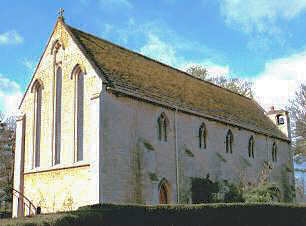
Oundle chapel from the north-east, 2000.
© Peter Higginbotham.
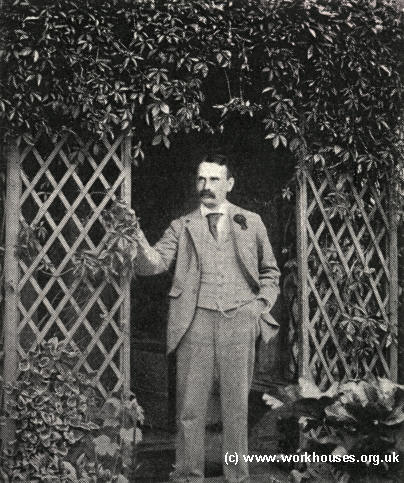
Oundle workhouse master, c.1894.
© Peter Higginbotham.
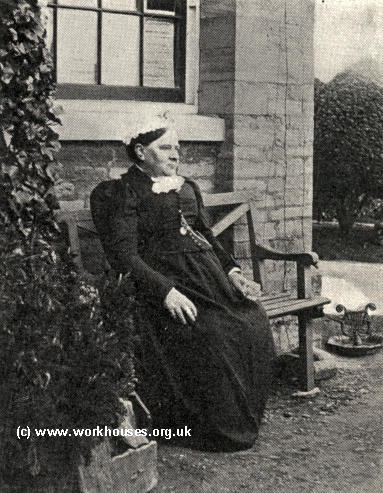
Oundle workhouse matron, c.1894.
© Peter Higginbotham.
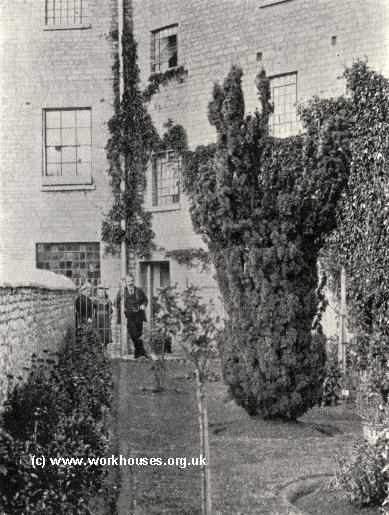
Oundle workhouse master and women's yard, c.1894.
© Peter Higginbotham.
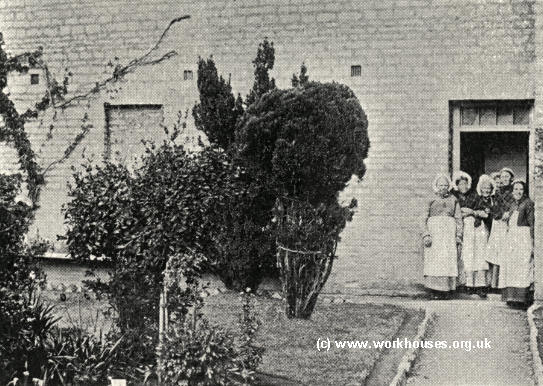
Oundle workhouse female inmates, c.1894.
© Peter Higginbotham.
A casual ward for the overnight accommodation of tramps stood at the north-west corner of the site. In front of the block was large patch of rhubarb used by the workhouse kitchens in dishes such as rhubarb pudding.
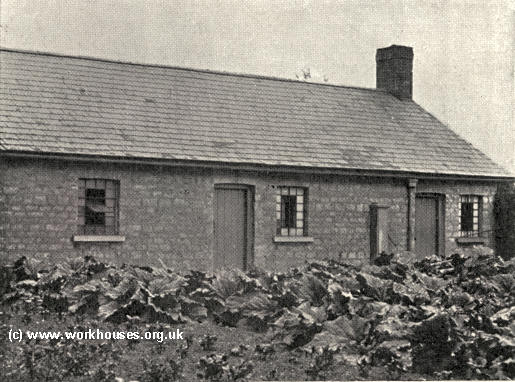
Oundle workhouse casual ward, c.1894.
© Peter Higginbotham.
The workhouse later became Glapthorne Road Hospital. The main workhouse block has now been demolished and the site is occupied by a residential care home. The surviving parts of the building have now been adapted for local community use including Oundle public library.
Staff
Inmates
Records
Note: many repositories impose a closure period of up to 100 years for records identifying individuals. Before travelling a long distance, always check that the records you want to consult will be available.
- Northamptonshire Record Office, Wootton Hall Park, Northampton, Northants, NN4 8BQ. A wide variety of records survive including: Guardians' minutes (1835-1930); Births register (1877-1913); Deaths register (1848-1914); Admissions and discharges (1836-1926); Punishment books (1870-1915); Lunatics register (1876-1929); Creed registers (1869-89, 1896-1914); etc.
Bibliography
- Higginbotham, Peter The Workhouse Encyclopedia (2014, The History Press)
Links
- None.
Unless otherwise indicated, this page () is copyright Peter Higginbotham. Contents may not be reproduced without permission.


